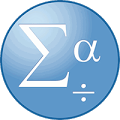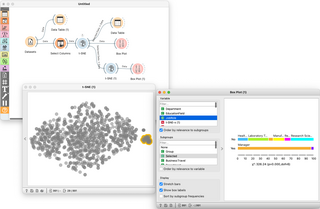Multivariate statistics is a subdivision of statistics encompassing the simultaneous observation and analysis of more than one outcome variable, i.e., multivariate random variables. Multivariate statistics concerns understanding the different aims and background of each of the different forms of multivariate analysis, and how they relate to each other. The practical application of multivariate statistics to a particular problem may involve several types of univariate and multivariate analyses in order to understand the relationships between variables and their relevance to the problem being studied.
Psychological statistics is application of formulas, theorems, numbers and laws to psychology. Statistical methods for psychology include development and application statistical theory and methods for modeling psychological data. These methods include psychometrics, factor analysis, experimental designs, and Bayesian statistics. The article also discusses journals in the same field.
Data mining is the process of extracting and discovering patterns in large data sets involving methods at the intersection of machine learning, statistics, and database systems. Data mining is an interdisciplinary subfield of computer science and statistics with an overall goal of extracting information from a data set and transforming the information into a comprehensible structure for further use. Data mining is the analysis step of the "knowledge discovery in databases" process, or KDD. Aside from the raw analysis step, it also involves database and data management aspects, data pre-processing, model and inference considerations, interestingness metrics, complexity considerations, post-processing of discovered structures, visualization, and online updating.

SPSS Statistics is a statistical software suite developed by IBM for data management, advanced analytics, multivariate analysis, business intelligence, and criminal investigation. Long produced by SPSS Inc., it was acquired by IBM in 2009. Versions of the software released since 2015 have the brand name IBM SPSS Statistics.

SAS Institute is an American multinational developer of analytics and artificial intelligence software based in Cary, North Carolina. SAS develops and markets a suite of analytics software, which helps access, manage, analyze and report on data to aid in decision-making. The company's software is used by most of the Fortune 500.

In statistics, exploratory data analysis (EDA) is an approach of analyzing data sets to summarize their main characteristics, often using statistical graphics and other data visualization methods. A statistical model can be used or not, but primarily EDA is for seeing what the data can tell us beyond the formal modeling and thereby contrasts traditional hypothesis testing. Exploratory data analysis has been promoted by John Tukey since 1970 to encourage statisticians to explore the data, and possibly formulate hypotheses that could lead to new data collection and experiments. EDA is different from initial data analysis (IDA), which focuses more narrowly on checking assumptions required for model fitting and hypothesis testing, and handling missing values and making transformations of variables as needed. EDA encompasses IDA.

SAS is a statistical software suite developed by SAS Institute for data management, advanced analytics, multivariate analysis, business intelligence, criminal investigation, and predictive analytics. SAS' analytical software is built upon artificial intelligence and utilizes machine learning, deep learning and generative AI to manage and model data. The software is widely used in industries such as finance, insurance, health care and education.
SUDAAN is a proprietary statistical software package for the analysis of correlated data, including correlated data encountered in complex sample surveys. SUDAAN originated in 1972 at RTI International. Individual commercial licenses are sold for $1,460 a year, or $3,450 permanently.
StatSoft is the original developer of Statistica. Dell acquired it in March 2014. Statistica is an analytics software portfolio that provides enterprise and desktop software for statistics, data analysis, data management, data visualization, data mining, which is also called predictive analytics and quality control.
Statistica is an advanced analytics software package originally developed by StatSoft and currently maintained by TIBCO Software Inc. Statistica provides data analysis, data management, statistics, data mining, machine learning, text analytics and data visualization procedures.

Orange is an open-source data visualization, machine learning and data mining toolkit. It features a visual programming front-end for explorative qualitative data analysis and interactive data visualization.

Data and information visualization is the practice of designing and creating easy-to-communicate and easy-to-understand graphic or visual representations of a large amount of complex quantitative and qualitative data and information with the help of static, dynamic or interactive visual items. Typically based on data and information collected from a certain domain of expertise, these visualizations are intended for a broader audience to help them visually explore and discover, quickly understand, interpret and gain important insights into otherwise difficult-to-identify structures, relationships, correlations, local and global patterns, trends, variations, constancy, clusters, outliers and unusual groupings within data. When intended for the general public to convey a concise version of known, specific information in a clear and engaging manner, it is typically called information graphics.

EViews is a statistical package for Windows, used mainly for time-series oriented econometric analysis. It is developed by Quantitative Micro Software (QMS), now a part of IHS. Version 1.0 was released in March 1994, and replaced MicroTSP. The TSP software and programming language had been originally developed by Robert Hall in 1965. The current version of EViews is 13, released in August 2022.

John P. Sall is an American billionaire businessman and computer software developer, who co-founded SAS Institute and created the JMP statistical software.
The SAS language is a fourth-generation computer programming language used for statistical analysis, created by Anthony James Barr at North Carolina State University. Its primary applications include data mining and machine learning. The SAS language runs under compilers such as the SAS System that can be used on Microsoft Windows, Linux, UNIX and mainframe computers.

IBM SPSS Modeler is a data mining and text analytics software application from IBM. It is used to build predictive models and conduct other analytic tasks. It has a visual interface which allows users to leverage statistical and data mining algorithms without programming.
Eureqa was a proprietary modeling engine created in Cornell's Artificial Intelligence Lab and later commercialized by Nutonian, Inc. The software used genetic algorithms to determine mathematical equations that describe sets of data in their simplest form, a technique referred to as symbolic regression.
The High-performance Integrated Virtual Environment (HIVE) is a distributed computing environment used for healthcare-IT and biological research, including analysis of Next Generation Sequencing (NGS) data, preclinical, clinical and post market data, adverse events, metagenomic data, etc. Currently it is supported and continuously developed by US Food and Drug Administration, George Washington University, and by DNA-HIVE, WHISE-Global and Embleema. HIVE currently operates fully functionally within the US FDA supporting wide variety (+60) of regulatory research and regulatory review projects as well as for supporting MDEpiNet medical device postmarket registries. Academic deployments of HIVE are used for research activities and publications in NGS analytics, cancer research, microbiome research and in educational programs for students at GWU. Commercial enterprises use HIVE for oncology, microbiology, vaccine manufacturing, gene editing, healthcare-IT, harmonization of real-world data, in preclinical research and clinical studies.












